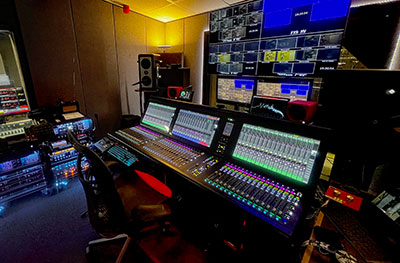Having established operations at Versa Manchester Studios, formerly the home of Granada Television in Manchester, England, in 2018, Spiritland Productions used the Netflix unscripted series Building the Band to inaugurate its new immersive audio control room. Central to the production work was a new Solid State Logic System T S400-48 console that handled all the music elements, including a Dolby Atmos 7.1.4 mix.
Spiritland Productions was founded by ex-BBC engineers Antony Shaw and Gareth Iles and – using industry-leading technology like the SSL System S500 mixing platform in the Spiritland One OB – aimed primarily at live music broadcast.
 Work on Building the Band used multiple studios across Spiritland campus, as well as space across the street at Aviva Studios. The team built out a massive Dante network to feed dozens of reality dialogue and vocal radio microphones together with band and other inputs to FOH and monitors, with the System T S400-48 as music console and a production console.
Work on Building the Band used multiple studios across Spiritland campus, as well as space across the street at Aviva Studios. The team built out a massive Dante network to feed dozens of reality dialogue and vocal radio microphones together with band and other inputs to FOH and monitors, with the System T S400-48 as music console and a production console.
Spiritland co-founding director Antony Shaw acquired the new console at the request of Oliver Waton, head of department for audio and lead sound supervisor on Building the Band, which is from production company Remarkable Entertainment. The competition series aims to create ‘the next great pop vocal group’, with 50 contestants forming bands without meeting face-to-face, relying instead on musical compatibility, chemistry and vibe.
With an initial house band rehearsal cancelled, Waton got his first opportunity to use the S400 on the opening day of production: ‘I’m quite familiar with Anthony’s workflow in the truck, so I just dialled in approximate EQs, threw all the faders to zero and let the monitor guys gain-up all the preamps. The band started playing and I said, “there’s the mix”. Since then, I’ve only had to do light tinkering; System T sounds fantastic with minimal processing changes required.’
‘It’s great that SSL offers a console with the compact form factor of the S300, but with the premium control we’re used to from our existing S500 console,’ Shaw says. ‘The workflow, features and sound are identical, but now we can have the visual feedback we want in a compact package, Obviously, the S400 sounds identical to the S500, the EQ is colourful and sonically correct to what we would expect it to sound like. But listening to Ollie’s mixes on this project, the magic is in the digital summing buses glueing everything together.’
System T’s dedicated Signal Switchers have also proved a benefit to the show production, providing the ability to rapidly switch between two sets of inputs, with the outputs routed anywhere they are needed. As the series episodes progress, the dozens of contestants choose amongst themselves, sight unseen, to form groups of five singers.
‘But we never knew what order they were going to perform in,’ Waton says. ‘We had two sets of microphones, gained everything the same and then whichever order they came up in the show, we just switched between A or B. But I didn’t to select multiple B inputs; I routed the A inputs for those faders via the signal switcher, so one button push and it’s done.’
Because that toggling doesn’t affect the DAW replay inputs, he adds, ‘I’ve got the Pro Tools op sitting behind me who pops into replay, we tidy up a vocal take straight after it happens, print it and we’re moving on.’
System T’s FX Rack came in handy when Waton was mixing production feeds in an adjacent room. At the start of the show, contestants were in small, individual booths with a hidden omni microphone and a small loudspeaker, allowing them to converse with others in their group. The automixer on that production console wasn’t up to the task, he said, and there was no onboard noise suppression.
‘I ended up with an insert from the console on every channel via the FX Rack on the System T. I had 20 instances of noise reduction running on the S400 as inserts to the production board with all the mix-minuses post-automixer and post-noise reduction. It sounded totally dry, and you couldn’t tell that there was a speaker in the room playing other people’s voices.’

